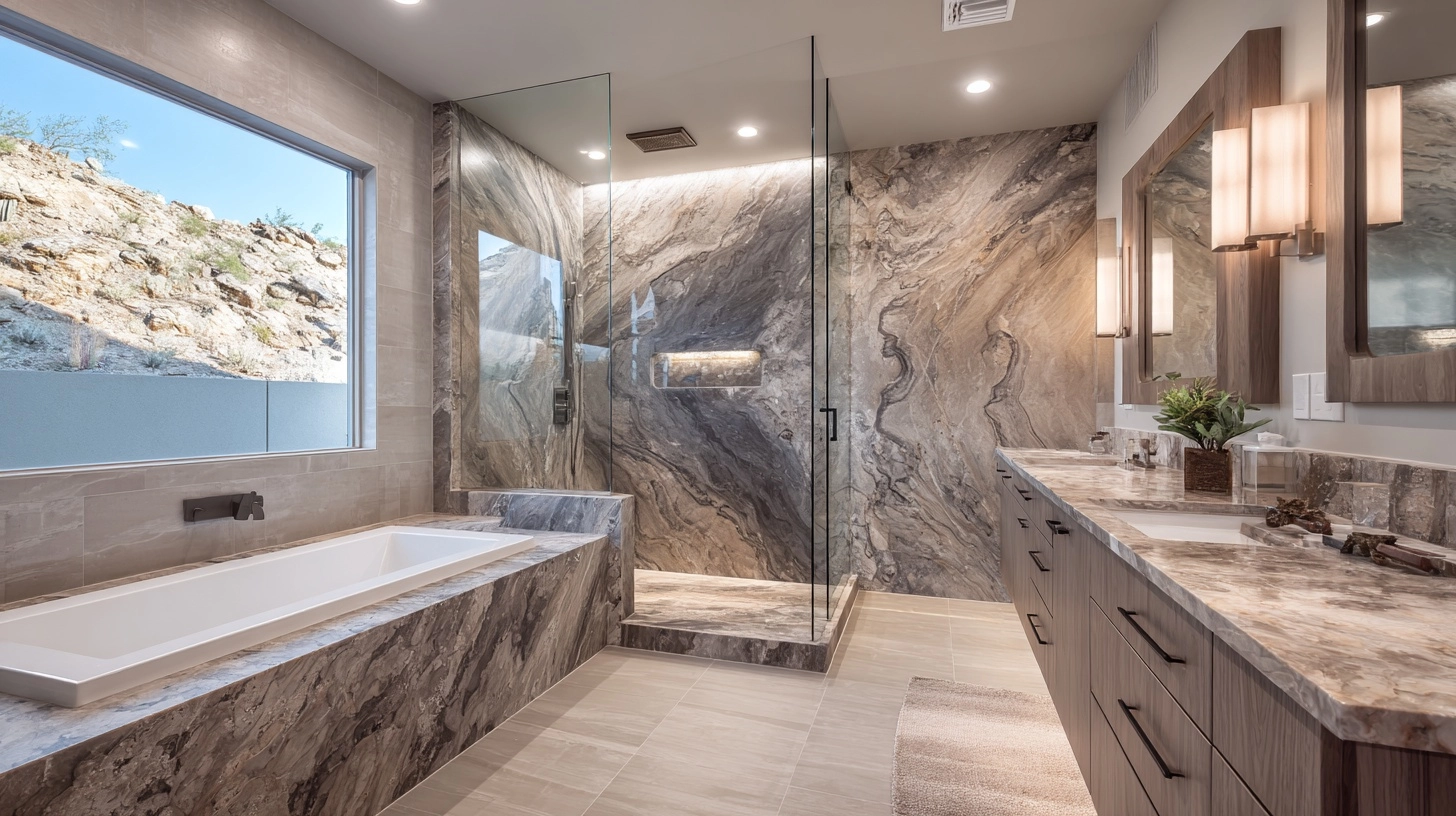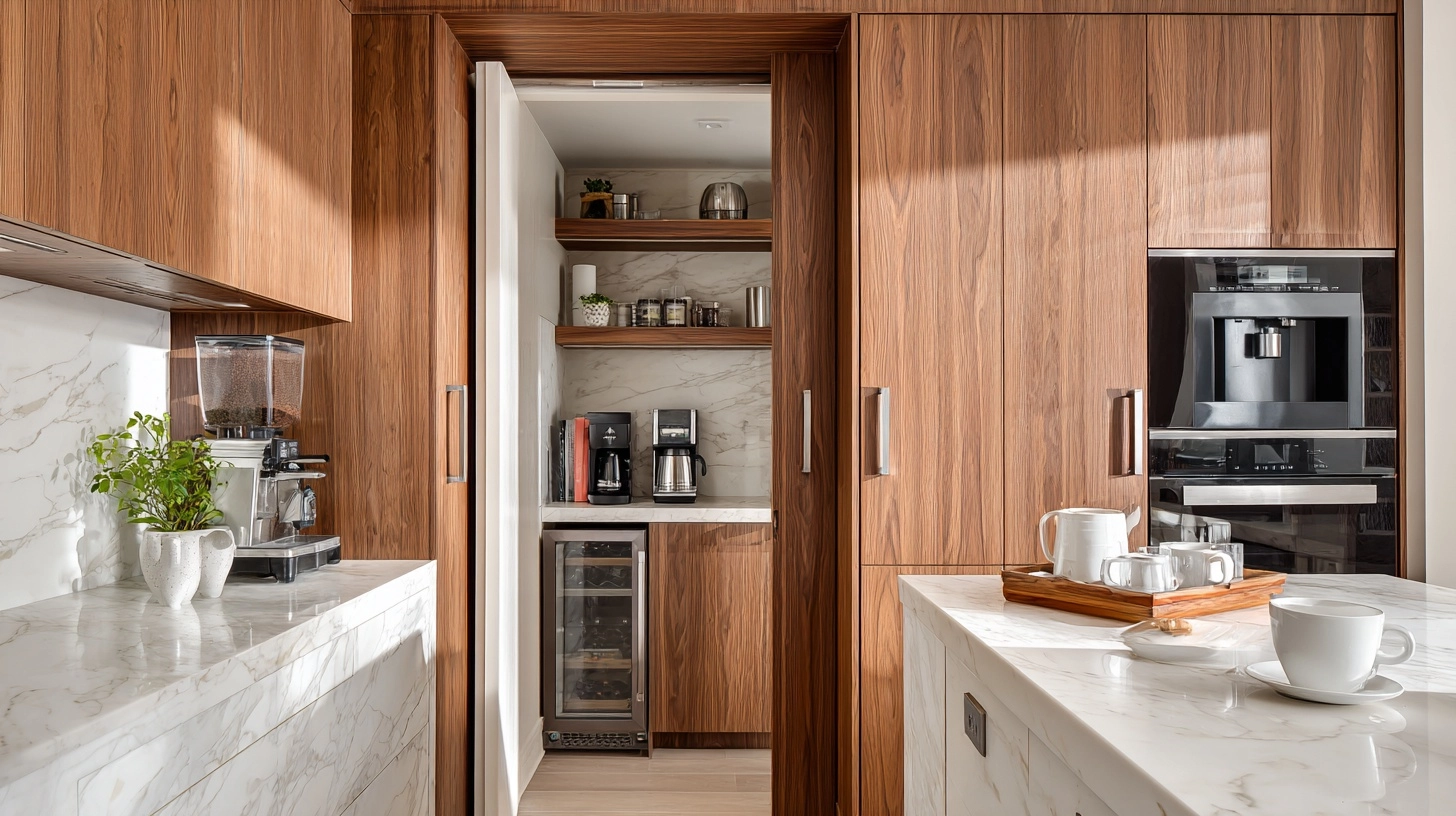
Warm Earthy Neutrals Taking Over Scottsdale Homes

Large-Format Porcelain Slabs: Smart Uses in AZ Homes

The kitchen, often lauded as the heart of the home, has long been a space for both utility and beauty. In Arizona, with its dynamic climate and penchant for gathering, kitchen designs have historically prioritized open plans and central islands. However, contemporary living invites us to reconsider these conventions, seeking arrangements that honour tradition while embracing innovation. For those with a keen eye for detail—be they design enthusiasts, seasoned professionals, or homeowners seeking the exceptional—exploring inventive kitchen layouts offers a world of opportunities beyond the well-trodden path of the island. In this discourse, we examine how to forge kitchens that balance functionality with striking aesthetics, all while weaving in touches of classic British refinement and adapting to the distinctive Arizona milieu.
Open-plan kitchens have reigned supreme in contemporary design, particularly in Arizona, where entertaining flows seamlessly from kitchen to living area. Yet, there’s a quiet sophistication in the “broken plan” concept—a layout that maintains openness while cleverly crafting delineation through architectural details, varying ceiling heights, or strategic cabinetry placement.
Imagine a kitchen where a half-wall or decorative screen discreetly segments prep areas from relaxation zones. Glass partitions, crittall-style doors, or even a row of freestanding bookcases can partition space without hindering light or visual connectivity. This approach is invaluable for the Arizona lifestyle, accommodating both large-scale gatherings and more intimate moments—offering a hint of enclosure to corral culinary activity (and the inevitable detritus) without sacrificing the all-important sense of flow.
Historically, British country homes have mastered the art of subtle separation—pantries, sculleries, and butler’s nooks offering efficient, compartmentalized function within a unified whole. Translating this into an Arizona context, one might pair a sun-soaked kitchen zone with a cozy breakfast alcove or concealed scullery, forming spaces that cater to the demands of modern family life without the constant exposure of every square inch.
The broken plan respects both the need for sociability and the desire for sanctuary—an elegant compromise between tradition and progress.
For many, “galley kitchen” conjures a vision of cramped urban quarters, yet this classic layout—born of efficiency—has taken on a new lease of life in southwestern homes. With artful design, a galley can become the height of sophistication, transforming narrow footprints into culinary catwalks with an aura of exclusivity.
The contemporary galley delights in symmetry, pairing banks of cabinetry facing one another, with generous worktops and high-end appliances arrayed in easy reach. In an Arizona setting, maximizing natural light is key: skylights, clerestory windows, or glazed doors opening onto patios can infuse galley kitchens with brightness, while reflective materials—think hand-glazed tiles or polished stone—amplify the sense of airiness.
What sets today’s luxury galley apart is its interplay between precision and indulgence. Clever storage (including concealed spice cupboards and stackable trays), layered lighting (recessed strips, pendant clusters), and statement finishes—such as bespoke joinery or hand-forged hardware—create a harmonious marriage of tradition and innovation. For social occasions, a peninsula or pass-through counter can anchor one end, blurring the boundary between chef and guest without compromising spatial discipline.
In a nod to the British heritage of functional beauty, consider integrating a tea or coffee station within the galley—a civilised touch that elevates everyday routines into rituals of pleasure.
L-shaped and U-shaped kitchens represent the unsung heroes of residential layout: flexible, efficient, and superbly adaptable to varying room sizes and social needs. In Arizona, where homes range from historic ranches to sleek new builds, these configurations offer remarkable versatility without defaulting to the island-centric archetype.
An L-shaped kitchen, for example, carves flow and function around two adjacent walls, freeing up central space for a striking dining table or soft seating—inviting homeowners and guests to engage in culinary theatre or casual conversation. Layers of British refinement can be realized through painted cabinetry in deep, saturated hues, period-style fixtures, or the addition of a bespoke banquette for leisurely breakfasts.
Meanwhile, the U-shaped kitchen excels at creating a true sense of enclosure—a cocoon for culinary creation, with an abundance of worktops and storage. For larger Arizona homes, the U-shape can be expanded to accommodate integrated appliances, smart technology, and even a concealed drinks bar—all tucked neatly away but immediately accessible. This format is especially conducive for multi-generational households or those who revel in hosting, offering generous prep zones and clearly demarcated work triangles for efficiency.
Crucially, these layouts support circular circulation—enabling multiple cooks to glide about their business without collision. Pair with underfloor cooling, natural clay tiles, or woven textiles for a tactile interplay between tradition and the Arizona climate.
Recent years have witnessed a renaissance of the pantry—not merely as a storage adjunct but as an integral, showstopping element of kitchen design. Inspired by historic English country homes, where a larder or scullery provided both utility and elegance, the Arizona pantry is evolving into a statement space—part private prep zone, part curated storehouse.
Rather than one monolithic kitchen, consider a dual-space approach. The main kitchen is reserved for socialising and finishing touches, while a fully equipped “back kitchen” or pantry area handles the heavier culinary lifting: baking, staging, or wine service. This arrangement addresses the increasing demand for immaculate entertaining spaces. When guests arrive, everyday mess disappears behind a pocket door, leaving the principal kitchen immaculate and inviting.
Smart use of climate control and ventilation is essential here, given the Arizona heat. Incorporate cooling drawers, wine fridges, or temperature-sensitive storage for specialty produce. Aesthetically, pantries can become design gems in their own right—think crittall glass doors showcasing elegant displays of crockery, artisanal shelving crafted from local walnut, or even a whimsical wallpapered backdrop.
This zoning strategy reflects both British formality and southwestern pragmatism, yielding a harmonious marriage of hospitality and order.
Ultimately, the transition “beyond the island” is not about discarding the familiar but about embracing a deeply personalized, context-aware approach to kitchen design. The most celebrated kitchens in Arizona are those that blend the enduring grace of British-inspired detailing with innovative layouts tailored to contemporary lifestyles and the specific joys—and challenges—of our unique environment.
Whether through the nuanced partition of a broken plan, the precise luxury of a reimagined galley, the timeless adaptability of L- or U-shaped layouts, or the quiet grandeur of a pantry-first arrangement, today’s kitchen aspirations are limited only by imagination and vision. Each space has the potential to reflect the individuality of its occupants, honour tradition, and boldly respond to the rhythms of Southwestern living.
For those seeking to redefine their culinary core, collaboration with a meticulous designer is indispensable. The aim is not to follow fads, but to create spaces that stand the test of time—where every detail, material, and layout choice tells a story of thoughtful curation and inspired reinvention. In doing so, Arizona’s kitchens become not merely places to cook, but sanctuaries of connection, artistry, and enduring elegance.
Disclaimer: The content provided in this article is for informational purposes only and is not intended as financial, tax, or investment advice. JL Coates is not a financial advisor, tax consultant, or investment specialist. We recommend consulting with a professional financial advisor, tax specialist, or investment advisor to discuss your specific circumstances before making any financial, tax, or investment decisions based on this information. JL Coates assumes no responsibility for any actions taken based on the information provided in this article.



